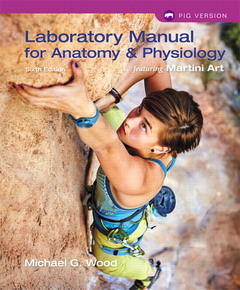Description
Laboratory Manual for Anatomy & Physiology featuring Martini Art, Pig Version (6th Ed.)
Author: Wood Michael
Language: English
Subjects for Laboratory Manual for Anatomy & Physiology featuring...:
816 p. · 24.6x27.4 cm · Loose-leaf
Description
/li>Contents
/li>Biography
/li>Comment
/li>
For two-semester A&P lab courses.
Stunning Visuals and Accessible Tutorials Engage Students in the A&P Lab
The Wood, Laboratory Manual for Anatomy & Physiology featuring Martini Art, Sixth Edition is a valuable resource for engaging students in the lab, introducing them to applications, and preparing them for their future careers. The Sixth Edition teaches effective drawing techniques to promote critical thinking and ensure lasting comprehension. This comprehensive lab manual features more than 100 new photos that walk students through core lab processes, lab equipment, and animal organ dissections, as well as art that is adapted from Ric Martini?s Fundamentals of Anatomy & Physiology, Tenth Edition. It is available in three formats: Main, Cat, and Pig Versions. The Cat and Pig manuals are identical to the Main Version, with nine additional cat or pig dissection exercises.
Note: You are purchasing a standalone product; MasteringA&P does not come packaged with this content. Students, if interested in purchasing this title with MasteringA&P, ask your instructor for the correct package ISBN and Course ID. Instructors, contact your Pearson representative for more information.
If you would like to purchase both the physical text and MasteringA&P, search for:
0134137728 / 9780134137728 Laboratory Manual for Anatomy & Physiology featuring Martini Art, Main Version Plus MasteringA&P with eText -- Access Card Package, 6/e
Package consists of:
- 0134130189 / 9780134130187 Laboratory Manual for Anatomy & Physiology featuring Martini Art, Main Version, 6/e
- 013415732X / 9780134157320 MasteringA&P with Pearson eText -- ValuePack Access Card -- for Laboratory Manual for Anatomy & Physiology, 6/e
Main Exercises
1. Laboratory Safety
2. Introduction to the Human Body
3. Organ Systems Overview
4. Use of the Microscope
5. Anatomy of the Cell and Cell Division
6. Movement Across Cell Membranes
7. Epithelial Tissue
8. Connective Tissue
9. Muscle Tissue
10. Neural Tissue
11. The Integumentary System
12. Body Membranes
13. Organization of the Skeletal System
14. The Axial Skeleton
15. The Appendicular Skeleton
16. Articulations
17. Organization of Skeletal Muscles
18. Muscles of the Head and Neck
19. Muscles of the Vertebral Column, Abdomen, and Pelvis
20. Muscles of the Pectoral Girdle and Upper Limb
21. Muscles of the Pelvic Girdle and Lower Limb
22. Muscle Physiology
23. Organization of the Nervous System
24. The Spinal Cord, Spinal Nerves, and Reflexes
25. Anatomy of the Brain
26. Autonomic Nervous System
27. General Senses
28. Special Senses: Olfaction and Gustation
29. Anatomy of the Eye
30. Physiology of the Eye
31. Anatomy of the Ear
32. Physiology of the Ear
33. The Endocrine System
34. Blood
35. Anatomy of the Heart
36. Anatomy of the Systemic Circulation
37. Cardiovascular Physiology
38. Lymphoid System
39. Anatomy of the Respiratory System
40. Physiology of the Respiratory System
41. Anatomy of the Digestive System
42. Digestive Physiology
43. Anatomy of the Urinary System
44. Physiology of the Urinary System
45. Anatomy of the Reproductive System
46. Development
47. Surface Anatomy
Pig Dissection Exercises
1. Pig Muscular System
2. Pig Nervous System
3. Pig Endocrine System
4. Pig Circulatory System
5. Pig Lymphoid System
6. Pig Respiratory System
7. Pig Digestive System
8. Pig Urinary System
9. Pig Reproductive System
APPENDIX: Weights and Measures
PHOTO CREDITS
INDEX
Michael G. Wood is a Professor of Biology at Del Mar College in Corpus Christi, Texas, where he has taught anatomy and physiology and biology for over 20 years. He has received the "Educator of the Year" and "Teacher of the Year" awards from the Del Mar College student body and from the local business community. He received his M.S. in 1986 at Pan American University, now the University of Texas at Pan American, where his research examined the ecological impact of an introduced species used widely in aquaculture (the blue tilapia) on the native fish population in the Rio Grande drainage of South Texas. He is a member of the Human Anatomy and Physiology Society (HAPS).
About the Lab Manual
- NEW: Draw It: Tutorials show students how to quickly and easily draw select structures and processes to better understand them.
- NEW: Pictorial instruction photos walk students through the steps of core lab processes and standard procedures in the field, such as how to examine microscopic structures.
- NEW: Model Photos are clear, precise anatomical model photos provided by the author.
- NEW: Stepwise Dissection Photos visually guide students through examinations of the following animal organs:
- Sheep brain
- Cow or sheep eye
- Sheep heart
- Sheep kidney
- NEW: Lab Equipment and Clinical Photos effectively train students how to work in labs and professional clinical settings. Photo topics include:
- Students using key lab equipment
- Clinical instruments and medical devices
- Clinicians performing procedures
- UPDATED: Drawing boxes are modifiable to enlarge and match the instructor's preferred look for the final assignment.
- UPDATED: Martini Art brings together a comprehensive program featuring histology micrographs by Michael Wood, and high-quality cat and pig dissection photos by the expert dissector and photographer team of Shawn Miller and Mark Nielsen at the University of Utah.
Abundant Tools for Practice and Review:
- QuickCheck Questions at the end of most activity introductions help students assess their understanding of the material before beginning the actual laboratory work.
- Clinical Application boxes present clinical information useful to students who plan a career in the allied health field. Students can apply this information by answering the Clini




